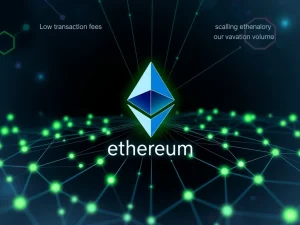Unlocking the Future: Ether Supercycle Debate Ignites Market Optimism

The cryptocurrency market is buzzing with a pivotal debate: could Wall Street’s increasing involvement trigger an Ether supercycle? This week, industry watchers discussed whether growing institutional adoption might push digital asset valuations beyond traditional four-year cycles. This development could reshape investment strategies for years to come.
The Ether Supercycle Debate: Wall Street’s Influence
A significant conversation has emerged regarding Ethereum’s native token, Ether (ETH). BitMine, the largest corporate holder of ETH, suggests that Wall Street’s embrace of blockchain technology could catalyze an unprecedented “supercycle.” This theory proposes that Ether’s price appreciation might extend well beyond the historic four-year market cycle, typically linked to Bitcoin’s halving events. Many believe this institutional influx signals a new era for crypto valuations.
However, not all market participants share this optimistic outlook. US investment bank Citigroup, for instance, maintains a more conservative stance. Citi has set a year-end price target for Ether at $4,300. This figure remains notably below ETH’s all-time high of $4,953, recorded on August 24. “Current prices are above activity estimates,” Citi noted, “potentially driven by recent buying pressure and excitement over use-cases.” Indeed, Ether has seen remarkable growth, rising about 108% over the past six months. Despite this, its price recently dipped 13% in a week, falling below the $4,000 mark for the first time since early August. This volatility underscores the ongoing market dynamics.
Source: Crypto News Insights
Source: Crypto News Insights/TradingView
Key points on the Ether Supercycle:
- Catalyst: Wall Street adoption and institutional capital.
- Impact: Price appreciation extending beyond traditional four-year cycles.
- Proponents: BitMine, citing growing accessibility and trading products.
- Skeptics: Citigroup, with more conservative price targets.
Circle Explores USDC Reversibility: A Clash of Ethos
Circle, a prominent stablecoin issuer, is reportedly exploring a controversial feature: reversible transactions for its Circle USDC stablecoin. This initiative aims to help users recover funds lost to fraud or hacks. Circle president Heath Tarbert confirmed these discussions, stating the company is examining mechanisms to roll back transactions. Yet, they also seek to maintain settlement finality. “There’s an inherent tension there,” Tarbert explained, “between being able to transfer something immediately, but having it be irrevocable.”
This concept directly challenges one of crypto’s foundational principles: transaction immutability. In decentralized systems, transactions are permanent and immune to unilateral changes. While reversibility could offer a safety net for scam victims and boost mainstream trust in stablecoins, it also raises concerns. Critics worry it could introduce a centralized point of control, undermining the very ethos of decentralization. The community awaits further details on how such a system would function and the parameters for deciding on reversals. This development marks a significant point of discussion within the stablecoin ecosystem.
Surging Decentralized Exchanges (DEXs) and Aster’s Dominance
The decentralized finance (DeFi) sector saw remarkable activity this week, especially within perpetual trading. Volumes on decentralized exchanges (DEXs) surged to an all-time high of $70 billion on Thursday. This impressive growth highlights renewed momentum in DeFi derivatives markets. Notably, this surge occurred over three consecutive days, with volumes hitting $52 billion on Tuesday and $67 billion on Wednesday.
A new derivatives platform, Aster, emerged as a dominant force. Operating on BNB Chain, Aster captured nearly $36 billion in 24-hour trading volume. This figure represented over 50% of the total perp DEX activity on Thursday. Aster significantly outpaced competitors like Hyperliquid and Lighter, both of which recorded volumes exceeding $10 billion. The increasing popularity of perpetual DEXs indicates a growing demand for leveraged trading in a non-custodial environment. This trend provides users with more control over their assets.
Source: DefiLlama
Why are Perpetual DEXs gaining traction?
- Non-custodial trading: Users retain control of their funds.
- High leverage options: Attracts experienced traders.
- Transparency: All transactions are on-chain.
- Innovation: New platforms like Aster are driving competition and features.
BlackRock Crypto ETFs Generate Substantial Revenue
BlackRock, the world’s largest asset manager, has demonstrated the immense profitability of cryptocurrency-based exchange-traded funds (ETFs). Their Bitcoin and Ether ETFs are generating an annualized revenue of $260 million. Specifically, Bitcoin ETFs contribute $218 million, while Ether products add $42 million. These figures, shared by Leon Waidmann of the Onchain Foundation, underscore a significant shift in traditional finance.
This success positions BlackRock’s crypto ETFs as a “benchmark” model. It encourages other traditional investment funds and pension funds to explore similar regulated products. “This isn’t experimentation anymore,” Waidmann emphasized. “The world’s largest asset manager has proven that crypto is a serious profit center.” He highlighted the rapid growth, comparing it to fintech unicorns that take a decade to achieve similar revenue. BlackRock’s venture into crypto ETFs serves as a crucial entry point for institutional investors into the digital asset world. It signals a robust and sustainable profit center.
Source: Leon Waidmann
Vitalik Buterin’s Vision: Open-Source Infrastructure
Ethereum co-founder Vitalik Buterin recently advocated for open-source, verifiable infrastructure across critical sectors. These include healthcare, finance, and governance. Buterin warned against relying on closed, opaque systems. He argued that such systems risk eroding trust and security as digital infrastructure becomes increasingly integrated into daily life. His vision emphasizes the importance of transparency and verifiability.
“The civilizations that gained the most from new waves of technology,” Buterin wrote in a blog post, “are not the ones who consumed the technology, but the ones who produced it.” He believes openness can combat global balkanization. Buterin envisions a future where verifiable devices form the backbone of global systems. He cautions against the default path of centralized, corporate-built digital tools. Instead, he urges a deliberate steering towards better, more open alternatives. This philosophical stance reinforces the core principles of decentralization and user empowerment.
The Broader DeFi Market and Ethereum Price Trends
The broader DeFi market experienced a mixed but generally positive week. Most of the top 100 cryptocurrencies by market capitalization ended the period in the green. However, some tokens faced significant declines. The Story (IP) token saw the week’s largest drop among the top 100, falling over 30%. Memecoin launchpad Pump.fun’s (PUMP) token also declined, down over 29% on the weekly chart. These movements highlight the dynamic and often volatile nature of the altcoin market.
Despite the recent dip, the overall sentiment around Ethereum price and the wider crypto market remains cautiously optimistic, especially with the institutional interest exemplified by BlackRock. Total value locked (TVL) in DeFi protocols continues to be a key metric for ecosystem health. As new innovations emerge and institutional adoption grows, the DeFi space is poised for continued evolution.
Source: DefiLlama
This week’s developments, from the compelling Ether supercycle debate to the surge in decentralized exchanges and the strategic moves by Circle and BlackRock, illustrate a rapidly maturing industry. Investors and enthusiasts alike are watching closely as these trends shape the future of digital finance.









